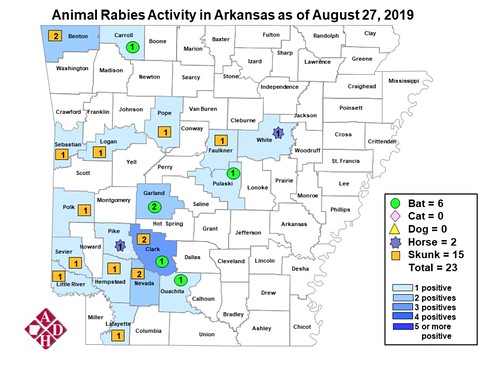Skunks, bats chief reservoirs for rabies in Arkansas
By Mary Hightower
U of A System Division of Agriculture
Fast facts
- Year-to-date rabies map show 15 reports of rabid skunks
- Report includes two rabid horses
- Extension fact sheet on rabies available: https://www.uaex.uada.edu/publications/pdf/FSA-8018.pdf
(428 words)
Download MS Word version
(Newsrooms: with art at - https://flic.kr/p/2h6WVE1)
LITTLE ROCK – There have been 23 reports of animals testing positive for rabies, according to a year-to-date map released by the Arkansas Department of Health.

“Skunks and bats are the main reservoirs for rabies in our state,” said Heidi Ward, extension veterinarian for the University of Arkansas System Division of Agriculture.
Fifteen rabid skunks and six rabid bats were reported from Jan. 1-Aug. 27 this year.
“We have had two horses positive for rabies this year,” she said, which is very unusual. “Last year, we had a positive cow.”
One of the horses was in White County, the other in Pike.
On the plus side, “so far, this has been a good year with low numbers,” she said. “Not long ago, we had over 100 cases by this time of year.”
In 2012, there were 131 cases of rabies, with 101 being skunks and 22 being bats. In 2013, that number leapt to 152 with 118 skunks and 26 bats. In 2014, there were 150 reports of rabid animals. Skunks made up 109 of those reports, with bats at 33. Numbers of reported infected animals began to decline in 2015.
“The weather has a huge impact” on the numbers of reported rabid animals, Ward said. “Wild animals are seen around populated areas more frequently during times of extreme heat and/or drought, presumably to seek out water sources.”
Both 2012 and 2013 saw areas of intense drought in Arkansas.
To see the maps from 1990-2018, visit https://www.healthy.arkansas.gov/images/uploads/pdf/Rabies_Maps_1990-2018.pdf. To learn more about the Arkansas Department of Health’s rabies reports, see: https://www.healthy.arkansas.gov/programs-services/topics/rabies.
Rabies can be transmitted from animals to humans through a bite and the saliva of an infected animal getting into the wound. It can also be transmitted if the virus-bearing saliva gets into mucous membranes of the eyes, nose and mouth. The virus works its way through the body’s nerves toward the brain. It is fatal when left untreated.
“This is a disease that can be prevented in people and domestic animals by a vaccine,” Ward said. “If someone sustains a bite from a bat or a skunk, be sure to clean the wound and see your doctor immediately. People should stay away from bats and skunks at all times, but especially if the animals appear sick or disoriented.”
Rabies kills more than 60,000 people worldwide every year, mostly in Asia and Africa.
For more information about this disease, see the fact sheet “Rabies” at https://www.uaex.uada.edu/publications/pdf/FSA-8018.pdf.
To learn about Extension Programs in Arkansas, contact your local Cooperative Extension Service agent or visitwww.uaex.uada.edu. Follow us on Twitter at @AR_Extension.
About the Division of Agriculture
The University of Arkansas System Division of Agriculture’s mission is to strengthen agriculture, communities, and families by connecting trusted research to the adoption of best practices. Through the Agricultural Experiment Station and the Cooperative Extension Service, the Division of Agriculture conducts research and extension work within the nation’s historic land grant education system.
The Division of Agriculture is one of 20 entities within the University of Arkansas System. It has offices in all 75 counties in Arkansas and faculty on five system campuses.
Pursuant to 7 CFR § 15.3, the University of Arkansas System Division of Agriculture offers all its Extension and Research programs and services (including employment) without regard to race, color, sex, national origin, religion, age, disability, marital or veteran status, genetic information, sexual preference, pregnancy or any other legally protected status, and is an equal opportunity institution.
Media Contact: Mary Hightower
Dir. of Communication Services
U of A Division of Agriculture
Cooperative Extension Service
(501) 671-2126
mhightower@uada.edu
Related Links